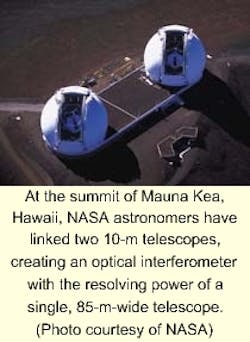
Stellar interferometry is rapidly evolving from a laboratory experiment to a mainstream observational technique used by astronomers to image stellar surfaces, multiple-star systems, clouds or disks of materials orbiting stars, and shadows of planets passing in front of stars. NASA astronomers recently created an optical interferometer with the resolving power of a single, 85-m-wide telescope by combining starlight from a pair of 10-m telescopes. A successful test at the W. M. Keck Observatory, on Mauna Kea, Hawaii, made the linked telescopes—known as the Keck Interferometer—the world's most powerful optical observing system (see figure). The astronomers plan to use the interferometer to search for planets around nearby stars and help NASA design future space-based missions to search for habitable, Earth-like worlds.
"This is a major step in the creation of a whole new class of astronomical telescopes," says Paul Swanson, Keck Interferometer project manager at NASA's Jet Propulsion Laboratory (JPL; Pasadena, CA). "Historically, breakthrough technologies like the Hale 200-inch and the Hubble Space telescopes have made discoveries way beyond the purpose for which they were originally built."
Overlapping the light from two separate telescopes can produce a pattern of light and dark bands. In spatial interferometry, the spacing of those bands and how they vary as the telescopes are moved tell astronomers about the structure of the light source at a much finer resolution than that of the individual telescope images.
Since 1995, astronomers have discovered almost 50 planets orbiting other stars. With current technology, which relies mainly on radial velocity techniques to detect planets in an indirect fashion, they can find very large worlds, 300 times as massive as Earth, that are located close to their parent stars. Such planets, known as "Hot Jupiters," are not likely to harbor life as we know it. Using a technique called interferometric nulling, the scientists working with the Keck Interferometer hope to directly detect Hot Jupiters. The powerful pair of telescopes might also reveal planets farther from their parent stars, which means their reflected light would be dimmer and harder to detect.
Nulling might also reveal faint dusty disks surrounding nearby stars, a telltale sign of planetary systems. Our own solar system is permeated with space dust. These tiny particles are left over from the formation of the planets billions of years ago, along with bits of debris from comets and asteroids. The amount of such dust orbiting other stars is poorly known, but perhaps not for long. The Keck Interferometer can sense clouds of so-called "exozodiacal dust" comparable in size to the dust swarm inside our own solar system. Exozodiacal dust is a noise source for future space missions like the Terrestrial Planet Finder (TPF), an interferometer that will seek out Earth-like planets by looking directly for their infrared emissions. By probing exozodiacal dust around nearby stars and by testing key technologies, the Keck Interferometer will be an important pathfinder for the TPF.
In early March, starlight from HD61294, a faint star in the constellation Lynx, was captured by both Keck telescopes and transported across a sophisticated optical system spanning the 85 m separating the two telescopes. In an underground tunnel, the collected lightwaves were combined and processed with a beam combiner and camera. In order to properly phase the two telescopes, adaptive optics removed the distortion caused by the Earth's atmosphere.
"This first light from the Keck Interferometer marks a dramatic step forward and will help us accomplish the ultimate goal of the Origins Program—to search for signs of life beyond examining the light from Earths' orbiting nearby stars," says Charles Beichman, chief scientist at JPL of NASA's Astronomical Search for Origins Program.
Testing will continue for the next several months. Limited science operations, including the search for planets, are expected to begin this fall. Scientists around the world will soon be invited to propose studies they would like to conduct using the Keck Interferometer. The proposals will undergo a formal review and selection process.
About the Author
Sally Cole Johnson
Editor in Chief
Sally Cole Johnson, Laser Focus World’s editor in chief, is a science and technology journalist who specializes in physics and semiconductors.
